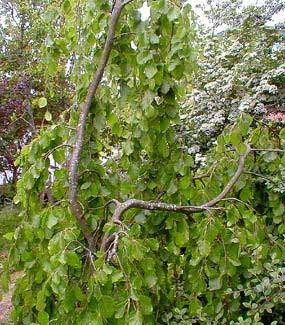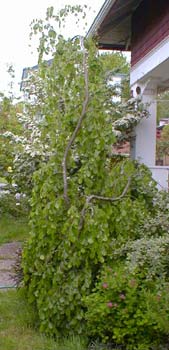
Weeping Green Beech in Spring
"A young beech tree on the edge of the forest
Stands still in the evening,
Yet shudders through all its leaves in the light air
And seems to fear the stars -
So are you still and so tremble."
-Richard Aldington
(1892-1962)
(1892-1962)
Shown here in two May portraits, the Weeping Green Beech (Fagus sylvatica 'Pendula') is a dramatic presence in the front yard, where it is one of the dominating visions as we sit on the porch gazing at this this beech on our left, a Rohani oak-leaf beech on our right, & a Paperbark maple further to the background.
This Northern European beech is positioned in full sun in well-draining ground. Beeches in general are intolerant of low soil oxygen, meaning they can die in poorly draining soil, but at the same time they prefer persistent moisture, though 'Pendula' is more drought-hardy than the majority. In areas with clay soil, alkaline soil, or dry soil, it will probably fail to thrive; but in light or humousy neutral or acidic soil, it will do well.
 At present we can gaze upon its upper limbs right outside our second-floor window, so it's got some good height to it, but nothing compared to what it can become, as it could well reach fifty feet someday.
At present we can gaze upon its upper limbs right outside our second-floor window, so it's got some good height to it, but nothing compared to what it can become, as it could well reach fifty feet someday.Weeping cultivars are produced by grafting onto a hardy rootstock. For a couple of years after initially grafted, they're rather sensitive & may not survive. But by obtaining a well developed specimen minimally around ten feet tall & with some girth on the leader, it will be well beyond its tender years, & will be a very long-lived tree.
Container-grown are best since they're so sensitive to transplanting. Transplanting them from out of a container insures a minimum of root shock, but even this may require two springs for full resettling, after which it will put on an unexpected burst of growth, & clothe itself densely in bright green leaves.
Most cultivars grow very slowly, but 'Pendula' is not bothersomely slow, not once it is settled & well rooted. So if at first it seems not to perform quite as expected, be a little patient, it will be more than rewarding just so long as you selected a specimen with aesthetic limb structure.
Typical growth habit of 'Pendula' is to have one very sturdy trunk, bent & gnarly, with this upright leader bowing near its slender top. Major branches begin with an upward angle but then quickly droop. Whether by habit, or by tradition in developing them for market, there will frequently be at least one sturdy horizontal limb that stretches forth to some distance, draped with leafy dangling stems. The beauty of individual specimens is greatly in the hands of the grafter/grower, as good training with an excellent eye for the best look has to occur before they reach market.
That horizontal limb (or limbs) grows further outward throughout the tree's life, & when the tree is thirty feet tall, a single outreaching limb could extend fifteen feet. If limbs begin to be too far-reaching in such a stretch, beeches are highly amenable to pruning, though ideally it is permitted its full reach since one of the great charms is a curtain of leaves that hangs from the one or two horizontal branches extending from out of the majority drooping branches.
Weeping behavior is extreme; the densely leafy twigs from the lower limbs will grow clear to the ground, & will occasionally need late-winter or spring pruning to get their tips up off the ground. Because of this tendency to grow wide & sweep the ground, it is not suitable to roadside plantings, but makes an ideal centerpiece for a yard or focal point for a hillside or vista.
It has year-round beauty. Autumn colors are golden & coppery (see the page of photos of the Weeping Green Beech in autumn). The bark, bared in winter, is thin, grey, mottled, & most attractive (see the page discussing the Weeping Green Beech in Winter).
Though in the main completely disease free, there is a variety of aphid that loves beeches. Aphids have not been much interested in our Rohani or our Black Swan beeches, but the weeping green beech had a terrible infestation its first year when it was somewhat weakened from planting shock. I still keep an eye on it every spring, & though a major infestation has not reoccurred, it does invite at least a little aphid activity each spring.
That first year I used the soapy water treatment but this seemed to have damaged sensitive spring leaves & didn't do some nearby broadleaf evergreen shrubs any good either, so I ended up feeling that soapy water for aphids though considered an organic treatment is nevertheless a bit harsh. The smaller infestations since have been managable first by spraying the hell out of the tree with a hose (aphids knocked in the grass cannot climb back into the tree), then that evening turning loose a few thousand aphids.
'Pendula' has been in existence since 1836 in England, & many later varieties are derived from it. In 1975, the Royal Horticultural Society honored 'Pendula' with the Award of Garden Merit. See also the Beechnuts Page.